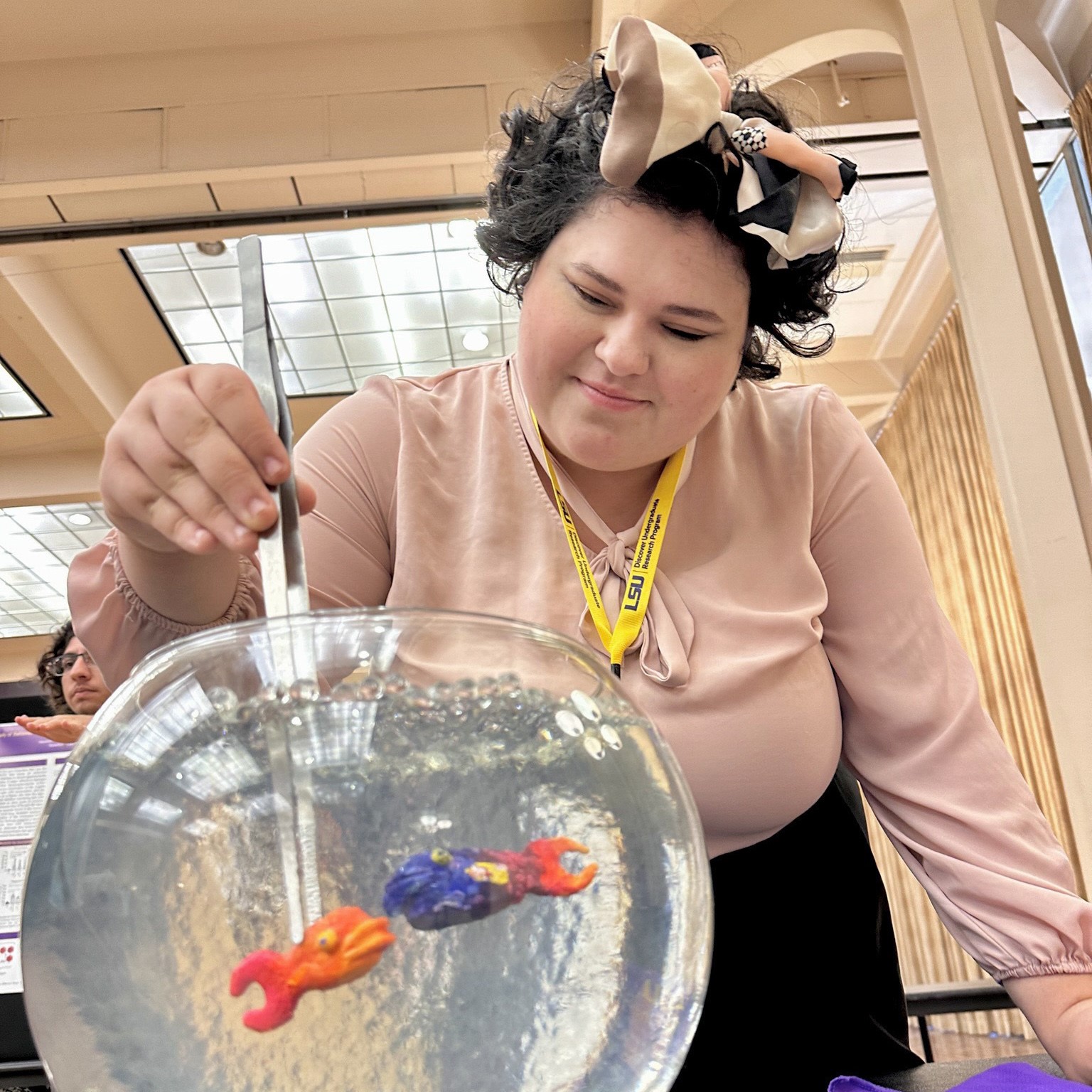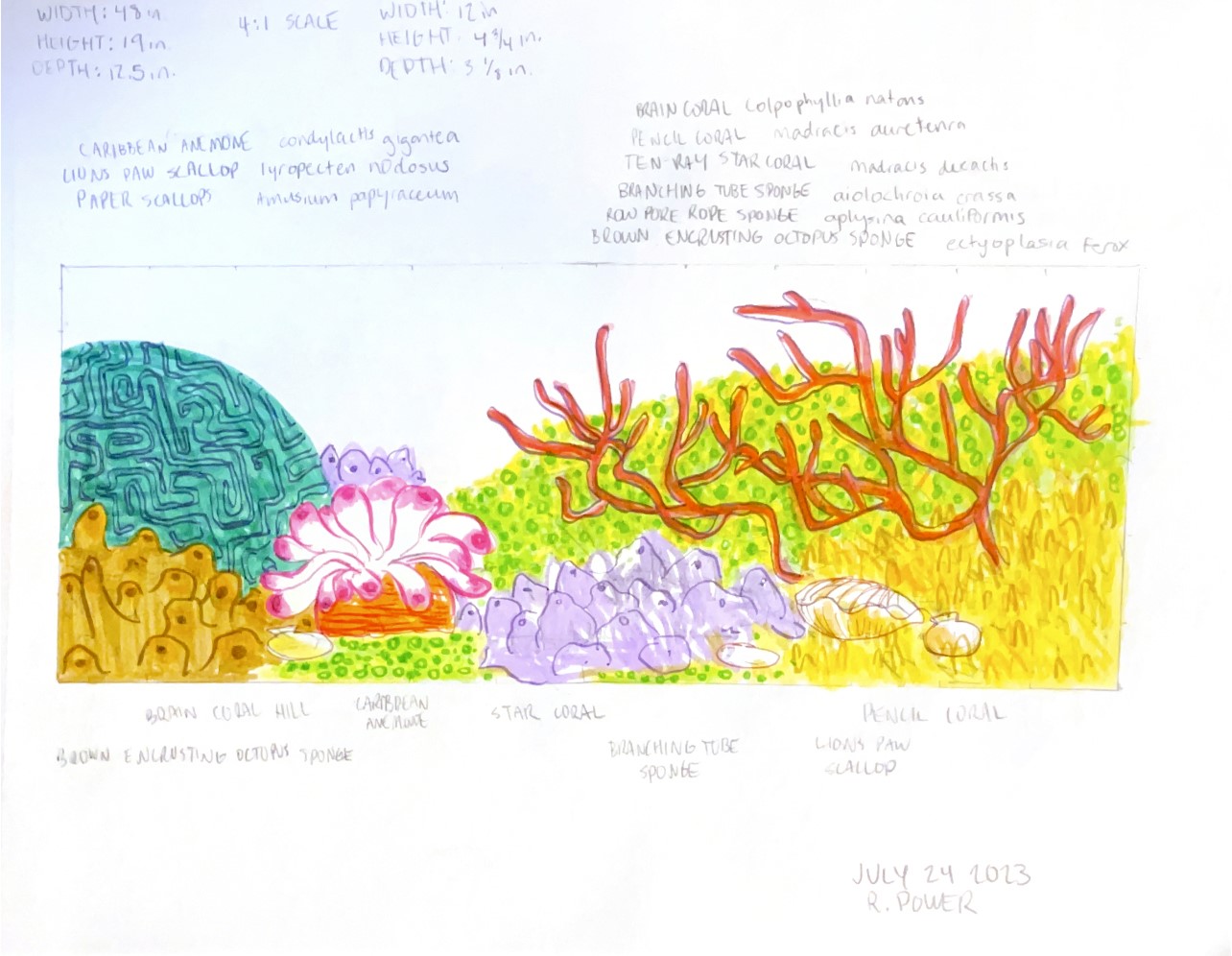Her Research Holds Water: Meet Art + Design Senior Kayla Dearman
October 05, 2023

Kayla Dearman, LSU Art + Design senior, has invented a new way to emulate water for stop motion animation using hydrogels. Photo taken at LSU Discover Undergraduate Research Program's Summer Undergraduate Research Forum (SURF) where Kayla presented both a display presentation and a lightning talk.
Dearman is the first in her family to go to college and the first to come up with a new technique to emulate water for stop motion animation, using non-toxic and biodegradable hydrogels, with support from the LSU McNair Research Scholars and the LSU Discover Undergraduate Research program.
Stop motion is a form of animation created from sequential photographs, which, when played in rapid succession, create the illusion of a moving image. Stop motion animators take one photo of a static object, move the object a little and snap another photo, move it again a wee bit and snap another photo, and continue this process until the photos can be put together and played back to create the appearance of fluid motion. Great examples of this artform include the film The Nightmare Before Christmas and the old Gumby TV show.
“Stop motion animation has long been a driving force for innovations,” said LSU senior, digital art major and stop motion animation aficionado Kayla Dearman. “But one environment that has yet to be successfully emulated by stop motion without considerable digital manipulation is the sea. Stop motion is usually unable to capture the complex movement of the sea-life and aquatic environment because of the unpredictability of water.”
Second only to her love of stop motion animation is water itself, particularly the ocean.
“My family visited the Gulf of Mexico a lot when I was younger,” Dearman explained. “It gave us a chance to connect with nature. My two older brothers and I would swim all day in the water and collect shells to bring home. The experience certainly helped connect me with the Gulf, which is why the deterioration of our oceans saddens me deeply. I hope our project helps preserve some of the beauty and diversity of our ocean’s coral reefs.”
The new project Dearman refers to brings her two passions together to develop a new and original technique to broaden the types of materials used in stop motion animation, advance research on animation and memorialize the beauty of the ocean’s natural coral reefs and fish.
“By using a simple solution of super-absorbent polymer beads, called hydrogels, and water in a transparent vessel, an artificial aquatic environment with imperceptible suspension is created,” continued Dearman, who graduates from LSU at the end of this semester.
Her study examined the efficacy of her animation technique and compared it to other attempts at emulating aquatic environments. It would seem her technique might be more difficult or costly than traditional forms of stop motion animation, but Dearman said that isn’t the case.
“Stop motion usually requires costly motion-rigging devices that give the illusion of weightlessness to objects being animated, plus a considerable amount of post-production digital manipulation,” she said. “Some of the ways they animate now involve metal rigging and things they have to edit out in post-production. Filmmakers will attach this steel arm to the back of puppets as they jump and fly through the air, so there’s this big silver piece of metal in every frame that they have to remove later, which creates a lot of extra work.” With her new technique, she explained, “Those rigs wouldn’t be necessary. Our technique makes the process of animating much simpler and much faster. Plus, it’s uniquely able to emulate the natural movement and turbulence of water.”
Dearman considers her new discovery—and the underwater animation work she’s done with it so far—to be a tribute to her love of the Gulf of Mexico.
“I love that the project stems around water and how it moves, which inspired me to go back and think about how I’ve connected with water,” she said. “Especially with what’s happening with the climate and how coral species are dying out quicker and quicker every year. I wanted to connect all of that within my project.”
She also wanted to help keep stop motion from becoming a forgotten artform, eclipsed by more modern technologies.
“Starting early in high school, I made short animations out of Play-Doh,” Dearman said. “I remember, for a biology class, I made a stop motion piece depicting all the different organelles inside of a cell, and making it break apart into pieces, then come back together, to show how it all works.”
She brought that process up several notches when she came to LSU.
“I really dove into it at LSU because of my professor Joseph Nivens, one of my mentors, who studied at LSU for his MFA,” Dearman said. “He had a passion and love for stop motion that really had an effect on me; I could see why he loved it so much—and that’s because it’s a very crafty medium. You get to build everything from flowers to spaceships when creating your set, and nothing compares to building and crafting a puppet that you get to see come to life.”
For Dearman’s research, various materials, sealants and puppet prototypes were tested to identify their uses and limits.
“The new methods I’ve investigated here have further implications for making stop motion animation more cost-effective and accessible in a way that is also environmentally friendly,” she said. “Stop motion traditionally uses a lot of foam latex, resins, clays and enamels that can sometimes be very toxic. So, I wanted to create a way to animate that’s not going to literally kill you over time.”

A sketch of sea life by Dearman’s research partner Reagan Power.
The answer to creating a stop motion environment that emulated realistic water ended up being hydrogels, meaning water beads, or Orbeez. Because of their spherical shape, elastic nature, transparency and propensity for being non-toxic and biodegradable, Dearman said hydrogels are the ideal material for her needs. When the hydrogels are placed in a transparent container in large quantities, with the remaining space filled with water, the hydrogel beads seem to disappear, creating the appearance of fluid water motion.
“I buy hydrogels on Amazon,” said Dearman, whose supplies are paid for by the McNair program at LSU. “It’s a trio program, designed to help prepare first-generation and low-income and diverse students for graduate school, and fund undergraduate research.”
Kayla's research is funded in part by the LSU Discover Project Grant which provided $3,000 toward the project.
Dearman first used her beloved hydrogels to create a simulated deep-sea environment in a small five-gallon bowl. She and her research partner Reagan Power filmed short animations to test the technique, which Dearman named Aqueous Polymeric Suspension, or APS. Dearman is ecstatic that she made a legitimate discovery and also got to name it herself.
Dearman’s next step is to continue experimenting while preparing to graduate soon. She now has a studio that she’ll be using to test her technique on a much larger scale, with a 55-gallon fish tank and more complex puppets. She recently presented her research at the McNair Heartland Conference in Kansas City, Missouri.
“Fun is a great word to describe it!” said Dearman about her work. “It’s definitely childlike and makes me connect with that side of myself. It’s fun just having my hands in a big bowl of Orbeez; it feels so cool, and they’re definitely wet!”


